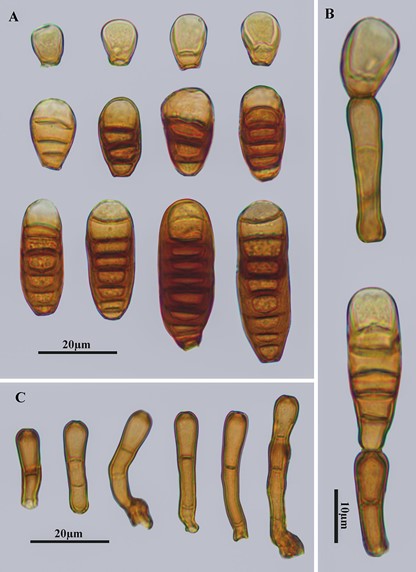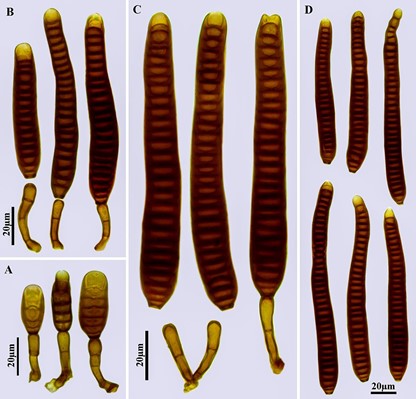Mesocorynespora sinensis Jian Ma, X.G. Zhang & R.F. Castañeda, sp. nov. Figs 1, 2
MycoBank number: MB 836512; Index Fungorum number: IF 836512; Facesoffungi number: FoF;
Differs from Solicorynespora spp. by its short, determinate conidiophores with multi- euseptate conidia, and from Corynespora spp. by its euseptate conidia.
Type: China, Jiangxi Province: Lushan Mountain, on decaying culms of bamboo, 9 November 2014, J. Ma (holotype, HJAUP M0296).
Etymology: refers to China where the fungus was collected.
Colonies on natural substrate effuse, brown to dark brown. Mycelium superficial and immersed, composed of branched, septate, pale brown to brown, smooth-walled hyphae. Conidiophores short, single or in groups, erect, straight or flexuous, clavate, unbranched, brown, smooth, 1–3-septate, 25–40 × 3.5–5 µm. Conidiogenous cells monotretic, integrated, terminal, determinate, clavate, brown, smooth, 9–14.5 × 5–6.5 µm. Conidial secession schizolytic. Conidia solitary, dry, acrogenous, obclavate, smooth, brown to dark brown, rounded and golden yellow at the apex, truncate at the base, 20–35-euseptate, 72–171 ×13.5–16 µm, tapering to 7–10.5 µm diam. at the apex, 4–5 µm diam. at the base.

Fig. 1. Mesocorynespora sinensis (holotype, HJAUP M0296). A. Developing conidia; B. Conidiophores with developing conidia; C. Conidiophores, and conidiogenous cells.

Fig. 2. Mesocorynespora sinensis (holotype, HJAUP M0296). A–C. Conidiophores, conidiogenous cells, and conidia; D. Conidia.
